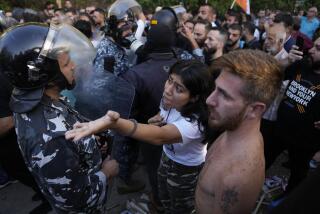Afghan Conflict Swirls Around Nomad Camps Near Kandahar, Cradle of Royalty
- Share via
KANDAHAR, Afghanistan — Evening campfires in the nomads’ camel-hide tents dance to a nightly staccato of gunfire from warring rebels and government soldiers on the desert plain outside this ancient provincial capital.
Turbaned men oblivious to the shots face southwest toward the Muslim holy city of Mecca to begin their evening prayer. Women in voluminous layers of colored cloth move about nearby.
The primitive nomad tribes have for centuries encamped near Kandahar’s satellite village of Argandab. Now, Soviet jets scream overhead.
Afghanistan’s war goes on around them and sometimes engulfs them.
Less than a mile from the nomads’ camp, Muslim guerrillas blast away at government military posts with recoilless rifles, rocket-propelled grenades and light and heavy machine guns.
The army’s artillery is an even match, but government troops have an advantage in air power from the Soviet Union. Newly introduced MIG-27 ground-attack fighters and Backfire bombers have blasted civilian and guerrilla targets since the beginning of November.
The question is how long the government can hold Kandahar, a key city, once the Soviet troops withdraw from Afghanistan. They are committed to do so by February.
In Argandab, where civilians far outnumber rebels, jets swept one recent day over the main bazaar, leveling a section of it, killing nine people and wounding 80 others.
A squat man with a gray beard said, “When I wake up in the morning until I go to sleep, I’m not sure about my life, that I will be alive 5 minutes from now because of the war.”
The old man, wrapped in a blanket, said he lived in Kandahar, once the capital of all Afghanistan.
Through the fine dust that hangs over the city, the pale blue dome of the Kalqi Sharif mosque can be seen from a distance. The mosque, which embodies the Islamic tenets propelling the rebel moujahedeen in their fight sits opposite the governor’s home, a stronghold of the Soviet-backed government.
The western entrance to the city is deserted but for the army and militia, tanks and trucks. Civilians are not seen except at the bazaar at Shaheedan Chowk, a pillared monument honoring Afghans killed fighting the British more than a century ago.
Kandahar, known as the city of kings, is the birthplace of generations of Afghan royalty. The ornate tomb of Ahmad Shah Durrani, the grandfather of Afghanistan’s exiled King Zahir Shah, is a venerated site of monarchists who are in the majority around Kandahar, both among the moujahedeen and civilians.
The rubble of blasted buildings chokes the streets, forcing motorized rickshaws and horse-drawn tonga carriages to steer an obstacle course through the bazaar.
Gul Lalai, a commander of the rebel National Islamic Front of Afghanistan, said the bulk of the damage near Herat Gate on the western edge of Kandahar occurred when fighter jets aiming at guerrilla positions in a nearby suburb missed their mark.
Evidence that the guerrillas have operated extensively in the city for years is the heavy tank-fire damage to the mud homes and shops.
About 50,000 people remain in Kandahar compared to a prewar population of about 200,000, making it second only in size to Kabul, Afghanistan’s capital.
Old men, women and children crowd daily into the bazaar before it closes at 2 p.m.
The free access of women and children is used by moujahedeen who employ youngsters to take supplies to rebel bases from the city.
More to Read
Sign up for Essential California
The most important California stories and recommendations in your inbox every morning.
You may occasionally receive promotional content from the Los Angeles Times.













